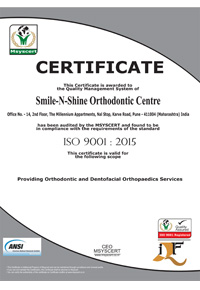How to keep your braces clean

Braces are those devices which are used to align and straighten teeth. These devices not only correct the position, improve the smile but also keep the mouth healthy and improve speech. If appropriate brushing techniques are not followed, we can develop stains, cavities or infected gums. Plaque and debris collect on the braces and need to be removed
Although a normal toothbrush will work, we must consider an electric or sonic toothbrush designed for cleaning braces, and assure that we are using the right amount of pressure, allowing the brush to rotate completely. This will provide a more successful cleaning and cut down on your time.
Use an interproximal brush with an angulated head and brush that can adapt to your braces. If you choose a regular electric or sonic toothbrush, it can be very difficult to use the brush well enough in your mouth with braces on. If you use a normal toothbrush, you will need to brush your teeth with the bristles angled bi-directionally. All sides of the teeth must be cleaned, so a toothbrush small and flexible enough to move easily around your mouth should be used.
Remove the plaque along the tooth closest to the gum line. Begin on the outer surface of your bottom teeth. Clench your teeth together. Move the brush back and forth across your teeth. Spit if necessary. Gently brush in small circles. With the mouth little open make sure your toothbrush reaches upto your behind teeth.
If you are using a normal toothbrush, angulate the brush at 45 degrees to help facilitate cleaning. This helps remove any food particles stuck directly on the top or bottom of your braces. Spend at least a few seconds on each bracket. You can also use your interdental brush to brush over the tops of your teeth. The inner sides of your teeth are easiest to clean as they are devoid of braces. Hold your brush perpendicular to the spaces between your teeth. Rub the brush back and forth and also use a round motion. This helps to get to reach crevices that can harbor plaque and food particles.
Massage your gums, cheeks and tongue as well. Spit if necessary.Turn the brush 180 degrees to face your cheek and clean similarly as on the inner and outer sides. Floss your teeth. Take a long piece of string floss (about 18 inches or 46 cm), wrap it around your index finger on each hand, and move it between each tooth space. Try to bend the string around the teeth on each side of it, forming a "C" shape, instead of flossing straight. That will remove any plaque stuck there. • If you have finishing wires, it can be almost impossible to get the floss underneath or over your double sets of wires, so just push the floss down, as described, into the tooth space; however, if you do not have your finishing wires, it's recommended to thread the floss underneath or over your wires because this is the most effective way to get rid of gingivitis and clean your teeth. • Consider using a water flosser if requires
Use mouthwash. Mouthwash will help clean areas where brush is unable to reach and also flush out food particles that further gather bacteria and turn into specks of calculus.
Gargle with luke warm water twice a day. Gargle once in the morning and once in the evening. It is a good practice to prevent halitosis and maintain good gum health. Rinse your toothbrush before and after brushing. Clean and preserve your toothbrush in a dry area so as to prevent bacterial growth and microbes. This will help keep you healthy. Replace your toothbrushes regularly. Replace your toothbrush every 3 months. When the bristles get frayed, the toothbrush won’t clean your teeth as well.











